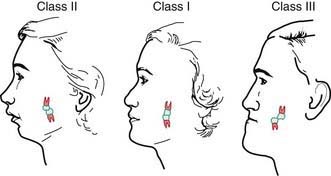Chapter 301 Malocclusion
Variations in Growth Patterns
Growth patterns are classified into 3 main types of occlusion, determined when the jaws are closed and the teeth are held together (Fig. 301-1). According to the Angle Classification of Malocclusion, in class I occlusion (normal), the cusps of the posterior mandibular teeth interdigitate ahead of and inside the corresponding cusps of the opposing maxillary teeth. This relationship provides a normal facial profile.
Buy Membership for Pediatrics Category to continue reading. Learn more here








